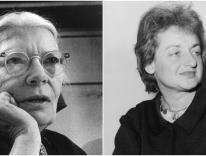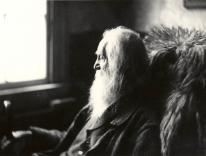This article first appeared in the January 4, 1957 issue of Commonweal
FEW OF US living in the present decade of the mid-century would claim we are passing through an age of all-pervading religious faith. Yet it can be said, with more assurance than many dared to assume thirty years ago, that Western culture, the culture of English-speaking peoples, is dependent upon knowing that we live within a Christian world.
During the past two centuries, since "the age of enlightenment" at least, people have sought out several substitutes for religion, the worst of these being cults of mystical salvation which after World War I took on elaborate titles such as "The Harmonious Development of Man." Other substitutes were biological science, social science, cult worship of Freud, Marx, of Communism, and of National Socialism as it was practiced in Germany and Italy. Behind (and in numerous cases after) these latter-day conversions were violent periods of disillusionment. After 1939 many substitutes for religious emotion and perception failed: the results (if one were still alive) were like the after-effects of drinking "restored" denatured alcohol.
During the present decade the age has become disillusioned with the results of disillusionment. Images of strange gods have become true monsters, and the human fall from grace has lacked tragic significance. The twentieth century's errors and mistakes are all too clearly the marks of naiveté and folly.
In our day (which is so unlike the world as it was known before 1914) to speak of religious emotions and beliefs, presupposes a dark background of economic depressions and world wars. All questions related to poetry and religion are today less academic than they seemed to be at the end of the nineteenth century. In 1900 George Santayana could approach those relationships with an air of calmness as well as a certain historical detachment: he explained with admirable clarity religious elements in the so-called Homeric Hymns, and then went on to tell how and why Platonism and Neo-Platonism became increasingly abstract ideals of goodness that lost their hold upon the imagination of the people. With this loss, both poetry and religion evaporated into the values of philosophic truths, unworldly enough perhaps, but lacking human passion and religions law. The dissolution of Paganism had taken place and the world waited on a new order of religious or divine inspiration, a sense of being that would re-establish an ancient trinity between man and men and man and God. The answers came in the books of the Old and New Testaments; the passion was reenacted in the life of Christ, and behind it the authority, the poetry of the Hebrew Godhead, its prophets and kings .... "But what overcame the world," wrote Santayana, "was what Saint Paul said he would always preach: Christ and him crucified."
In 1900 the Christian world looked back across the span of the nineteenth century, a century which as Santayana saw it had been bitterly torn by religious doubts and schisms, but the kind of horrors that have been the familiars of human experience today had scarcely arrived. It took a nineteenth-century writer of evangelical temper Rudyard Kipling—in his old age, in 1919, to express the terror, the discontent, of the thirty years that followed the writing of these lines:
As it will be in the future, it was at the birth
of Man—
There are only four things certain since Social
Progress began: —
That the Dog returns to his Vomit and the
Sow returns to her Mire,
And the burnt Fool's bandaged finger goes
wabbling back to the Fire;
And that after this is accomplished, and the
brave new world begins
When all men are paid for existing and no
man must pay for his sins,
As surely as Water will wet us, as surely as
Fire will burn,
The Gods of the Copybook Headings with
terror and slaughter return!
This was verse in the furious manner of what George Orwell called Kipling's "good-bad poetry"; but the angry clear-eyed British Colonial East Indian who in his manner was a nearly Hebraic prophet had his say in language that no one could misunderstand. Something like biblical fury had been translated into verse which converted the phrase "brave new world" into a memorable irony, and in which the present century has learned its discontents.
WITH THIS as prelude we come to a rediscovery of religious verse in the present mid-century, a decade in which the distance between poetry and religion seems much shorter. At no time was that distance very great—for in all literatures the sources of poetry are close to the sources of divine inspiration, and we need not repeat the welt-known anthropological-historical proofs of that relationship. Yet—and not so long ago—it was unfashionable to admit that religious feeling and the writing of poetry had valid associations. It was then more appropriate for a poet to be aware of his biological origins than to confess to a belief in God. The reasons for this peculiar turn of fashion were obvious. In England slightly past the middle years of the nineteenth century the best minds of the age felt the recession of established faith, and the realization of that feeling came in these famous lines from Matthew Arnold's "Dover Beach":
The Sea of Faith
Was once, too, at the full, and round earth's shore
Lay like the folds of a bright girdle furl'd.
But now I only hear
Its melancholy, long, withdrawing roar,
Retreating, to the breath
Of the night-wind, down the vast edges drear
And naked shingles of the world.
Nor was it easy in the two decades after the writing of "Dover Beach" for a Gerard Manley Hopkins to assert a reawakening of faith: to the profoundly aware and seriously minded poets of the age the melancholy lines of "Dover Beach" reverberated and returned as echoes heard within the ear. In America the undertones of Arnold's warning were less immediately heard. Our foundations in Puritan convictions were less easily shaken—and our Protestant sects with their evangelical-Wesleyan variations continued to flourish side by side and in company with the most blatant forms of commercial optimism. In 1894 Santayana wrote:
My heart rebels against my generation,
That talks of freedom and is slave to riches,
And, toiling 'neath each day's ignoble burden,
Boasts of the morrow.
His was a critical perception, that with Henry Adams' fear of the encroaching powers of Boston's State Street warned that all liberal thinking, including religious faith, would be submerged in mindless materialism. Yet Santayana's remarks were expressions of social and political discontent rather than religious verse. The uneasy intellectuals of the age joined forces with the writers of realistic fiction: Utopian socialism was offered as an end in view; and writers of mystical and poetic insight died in obscurity, Emily Dickinson in 1886, Herman Melville in 1891.
In America the critics of materialism were quasi-materialists themselves; they distrusted ~the unctuous appearances of men in clerical clothing as well as the charlatans of protestant faith, the ignorant preachers who with anti-intellectual fervor shouted, "Thou shalt not think!" The stage bad been set for American caricatures of religious authority in both biography and fiction: the lives of Henry Ward Beecher and Brigham Young, the intractable, gloomy realism of Harold Frederic's The Damnation of Theron Ware, which in the following two generations became transformed into the satires, Sinclair Lewis's Elmer Gantry and Erskine Caldwell's Journeyman.
The social conscience had become the literal substitute for religious feeling. It had become all too easy to regard a priest or a minister of God as a victim of sexual aberration; and by 1930 it took moral as well as intellectual courage to stand up in opposition to prevailing critical attacks upon the authority of established churches.
IN THE present century the first serious attention given to the reading of religious verse came with the rediscovery of the poems of John Donne. As T. S. Eliot remembers that date in America, the scene was a classroom in freshman English at Harvard, the lecturer was Professor Briggs, and the time was 1906.
A generation earlier in London, John Churton Collins, the critic and lecturer; A. C. Swinburne, and D. G. Rossetti had shared the enthusiasm of their mutual discovery of Donne. Swinburne and Rossetti were particularly vocal, for they had made two previous and important discoveries: the poems of William Blake and Whitman's Leaves of Grass. Donne added a third star to their firmament. Not long after their fervent approval, talk and speculation concerning Donne crossed the Atlantic and then caught the attention of lecturers in American universities.
In 1912 Professor Herbert J. C. Grierson's definitive edition of The Poems of John Donne gave the readings of John Donne's poems in college classrooms additional authority. Donne was then reread and admired as a metaphysical poet; less stress was placed upon the religious character of his "Holy Sonnets" than on the wit and tension of his earlier poems. Those who grew shy in the presence of religious sentiment could safely advance an interest in metaphysics. Ten years later the effort to be "metaphysical," to seek out a quasi-scientific cause for being, came into high fashion—provided one was not committed to a belief in God. The term was so attractive that groups of poets decided that all their friends wrote metaphysical poems, and if their poems were not precisely metaphysical and did not resemble in the least Donne's "Holy Sonnets," they could be read as "ontological" poems, an even stricter and more scientific term to express a search for the nature of reality. The term "metaphysical" could be extended to include the entire works of Shakespeare, Gray's “Elegy in a Country Churchyard," the poems of Emily Dickinson, and the writings of any living poet who was careful enough to use key words such as "brain," "bone," or "blood."
The next step toward a rediscovery of religious verse in English came with the publication in 1918 of Poems of Gerard Manley Hopkins, a posthumous volume (Hopkins had died in 1889) edited by the British poet laureate, Robert Bridges. Hopkins' technical innovations were as startling as any contributions made to "the new poetry" of the twentieth century. The publication of his book was proof to a younger generation of poets in the United States as well as in England that religious verse need not be sanctimonious or dull. The publication of his book, coming as it did after a revival of interest in the poetry of John Donne, reilluminated the religious elements discovered in Donne's "Holy Sonnets," and slowly the fashionable prejudice against religious verse began to decline. The way was still difficult and by no means clear: elements of religious emotion in the poetry of T. S. Eliot (when understood at all) were openly resented; and as recently as 1933 the essential religious quality that gave meaning to the poems of Hart Crane was frequently misread. Of the older poets in America, only Edwin Arlington Robinson sustained the austerities, the dignity, the wit, the difficult, often misread strictness of "the old tradition"— Puritan sharpness and restraint grown aristocratic— and Robinson was best known and admired for his latter-day Arthurian romances, which are written in blank verse.
Certainly a renewed appreciation of religious verse in English was as difficult of accomplishment in the twentieth century as the finding of deeply inspired religious poems. It was not until the latter 1930's that a public as well as critical response in that direction could be discerned. It began to make itself known with the production of T. S. Eliot's play in verse, Murder in the Cathedral, in New York and London theaters—and from that day to the present, a refreshed spirit, even through the disasters of a second world war, has attended the reading of religious verse. At the very least, we can say that the 1950's have permitted a rediscovery and renewed appreciation of religious literature.
Please email comments to [email protected] and join the conversation on our Facebook page.
Previous Story
Priest of the Immediate
Next Story
Christianity and Colonialism


